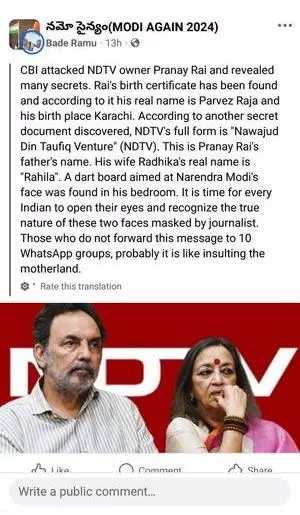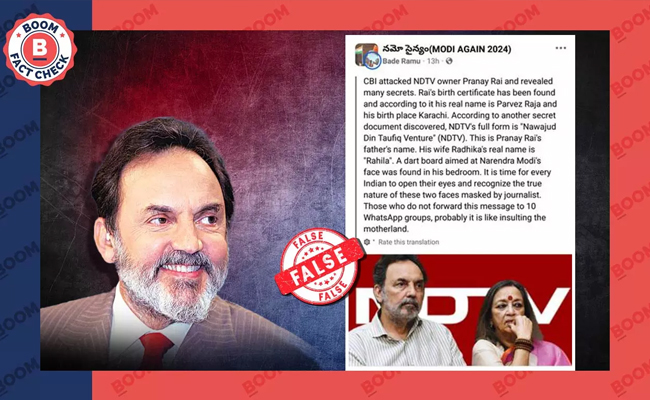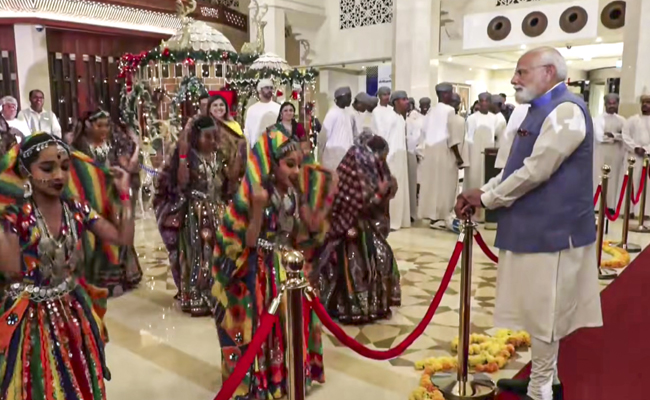Fact check by BOOM found that the CBI’s press release from 2017 does not mention Prannoy Roy’s full name, his father’s name, or his birthplace.
CLAIM: CBI has revealed secrets about Prannoy Roy, including his real name as Parvez Raja, born in Karachi, and NDTV’s full form as “Nawajud Din Taufiq Venture.
FACT CHECK: BOOM found that these claims about the CBI raid on Prannoy Roy are false and have been circulating since 2017. CBI's press note does not mention Prannoy Roy’s real name, his father’s name or his birthplace.
New Delhi: A viral social media post claims that during a 2017 CBI raid on former NDTV director and promoter Prannoy Roy, it was "revealed" that his real name was allegedly 'Parvez Raja' and that he was born in Karachi, Pakistan.
2017 CBI case against Prannoy Roy and Radhika Roy
The CBI on October 1, 2024, had submitted a closure report in a Delhi court in a case alleging cheating against former NDTV promoters and directors Prannoy Roy and Radhika Roy stating that there was "insufficient legally admissible evidence". The 2017 case was regarding Rs 48 crore loss suffered by ICICI Bank during a loan settlement in 2009.
Posts viral with false claims about Prannoy Roy
Posts are being shared on Facebook claiming that NDTV’s full form is actually ‘Nawajud Din Taufiq Venture’ and alleging that it is also the ‘real’ name of Prannoy Roy’s father. The posts further claim that Roy’s wife Radhika's ‘real name’ is Rahila and that the CBI found a dartboard with Prime Minister Narendra Modi’s face in Roy’s bedroom.
These claims are being shared on Facebook with a photo of the couple.

Fact-Check: 2017 CBI press note about raid on Prannoy Roy does not mention details claimed in viral post
BOOM found that the claims made in the viral post about the 2017 CBI raid on Prannoy Roy are false.
What does the 2017 CBI Press note mention?
We checked CBI’s official website and found a press release from June 6, 2017, detailing the searches conducted at Roy’s residence.
However, the release did not mention any of the claims made in the viral post, such as Prannoy Roy’s real name, his father’s name, his birthplace, or the original full form of NDTV.
“Reports in sections of the media have raised certain issues and the statement issued by NDTV has leveled certain allegations against the CBI investigation in the case relating to the promoters of NDTV and others. It is clarified that searches have been carried out at the premises of the promoters and their offices based on search warrants issued by the Competent Court. CBI has not conducted any search of the registered office of NDTV, media studio, news room or premises connected with media operations. CBI fully respects the freedom of press and is committed to the free functioning of news operations,” the press note stated.
In June 2017, the CBI had raided several residences and offices connected to Prannoy and Radhika Roy. The raids were in connection with an alleged loss of around Rs. 50 crores caused to ICICI Bank by NDTV.
In 2008, ICICI Bank gave a ₹375 crore loan to the NDTV promoters, using their 61% shareholding in NDTV as collateral. It was alleged that the bank later allowed them to repay the loan at a much lower interest rate (reduced from 19% to 9.5%), as per news reports. This reduction allegedly caused a ₹48 crore loss to ICICI Bank and benefited the promoters. The CBI looked into these claims, filed as a case in 2017 based on a complaint by Sanjay Dutt of Quantum Securities Ltd.
However, in November 2024, CBI closed the case on finding no wrongdoing by ICICI officials. Their closure report concluded that it was a standard transaction and there was no violation of law or criminal conspiracy involved.
Similar false claims on Roy viral in 2017
BOOM had debunked similar false claims that were circulating on WhatsApp about Roy's religion after the CBI raid at his residence in 2017.
The WhatsApp forwards had falsely claimed that Roy, born to a Bengali Hindu father and an Irish mother, was a member of the Redemption Cathedral in New Delhi. However, the office of The Cathedral Church of the Redemption had firmly denied these claims, stating that Roy was not a member.
(This story was originally published by boom, and republished by english.varthabharati.in as part of the Shakti Collective)
Let the Truth be known. If you read VB and like VB, please be a VB Supporter and Help us deliver the Truth to one and all.
Belagavi (Karnataka) (PTI): Karnataka Minister Priyank Kharge on Wednesday said the state government is working to appoint an agency to manage clean drinking water units in rural areas.
The state Rural Development and Panchayat Raj minister was responding to a question by Hirekerur MLA U B Banakar in the legislative assembly.
"In the rural areas of the state, many clean drinking water units have been set up under corporate social responsibility (CSR) grants, including contributions by MLAs and MPs, and handed over to gram panchayats. After the maintenance period, problems have arisen in keeping these units operational," Priyank said.
He added that a proposal has been made to award a maintenance contract to one of the country’s reputed drinking water unit manufacturing companies, but so far, no companies have come forward to take up the work.
ALSO READ: Woman threatens to end life as police official refuses to accept love proposal, FIR registered
"The government is continuing its efforts and will resolve this problem soon," he said.
On a query regarding fluoride content in water, the minister said water quality testing is being conducted monthly in all zilla panchayats.
"Laboratories have been opened for this purpose. Around 6.5 lakh water samples have been tested across the state, and water testing kits have been provided to villages," he added.





